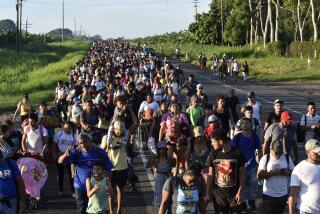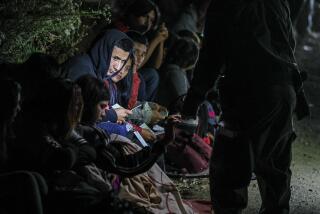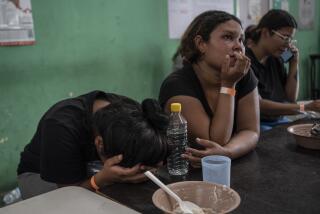Stricter Asylum Rules Cut Alien Influx in Texas
- Share via
BAYVIEW, Tex. — The flood of thousands of Central Americans seeking political asylum in the United States dwindled to a trickle Wednesday as word spread that immigration officials were making good on their vow to reject all but the most compelling of cases and detain other applicants in a tent city here.
In an apparent victory for the U.S. Immigration and Naturalization Service, only 30 Central Americans made the long journey Wednesday to the remote South Texas detention cen ter here where applications for asylum were being reviewed. The reason for the low turnout was obvious: of the 233 asylum applications processed the day before, only two were approved. Both were Nicaraguan men.
The remainder were held here at the Port Isabel Service Processing Center, in a remote area about 25 miles from Brownsville near the southern tip of Texas. Eventually 5,000 illegal aliens can be housed at the 315-acre facility.
Federal officials in Texas and Washington hailed the drop off in applications but stopped short of labeling it a trend. Duke Austin, a spokesman at INS headquarters in Washington, said: “You could anticipate (the drop) if frivolous applicants are detained.”
Advocates for immigrants agreed that the drop was predictable, but they asserted that it proves that people with legitimate claims of political persecution are being denied fair hearings.
Adopt New Procedure
Under earlier policy, persons who crossed the border and requested political asylum could remain free while their application was processed and travel wherever they wished. The INS, contending that less than 5% of the Central Americans applying for asylum could demonstrate flight from persecution, switched to a new procedure: applicants would be detained at the camp, where their requests would be processed. Those who do not meet the asylum criteria would remain in the camp until they can be deported.
Without such a policy, asylum applications from Central Americans would grow from 50,000 last year to 100,000 this year, the INS said.
U.S. District Judge Filemon Vela ruled on Jan 9 that for a period of 20 days, refugees in the valley could leave for other parts of the country while pursuing their asylum cases.
But Vela later ruled that the immigration service was empowered to keep refugees in the Rio Grande Valley while applications for asylum were being reviewed. The INS had contended that the applicants would only disappear if allowed to leave the valley.
The INS, still smarting from the tongue-lashing it received from Judge Vela over allowing people to live in abject conditions at the camp, did put up huge striped tents at the detention center so that the refugees would have shelter.
Linda Yanez, a lawyer representing the refugees, said she believed Central Americans would now slip over the border and try to make it out of the valley by sneaking past Border Patrol checkpoints.
“What difference does it make if they get arrested by the Border Patrol or get rejected after sitting all day in a hot tent waiting for a hearing,” she said. “In the long term, you are going to have very expensive detention that makes no sense whatsoever.”
At the detention center Wednesday, Silvestre Reyes, the chief Border Patrol agent for the valley, said 375 additional border patrolmen are being brought in to make crossing into the United States more difficult. He predicted that the detention center would fill up to its capacity of 5,000 with an increase in the number of aliens who are arrested by the beefed-up patrol.
“Once they realize we are here and here to stay, they are going to have to try their luck elsewhere,” he said.
Omer G. Sewell, the INS district director, said he hopes others in the Central American pipeline bound for the United States will take heed.
“I hope the message is getting out,” he said. “We’re trying to get the message out that you can’t misuse the laws in a wholesale way.”
On Wednesday, INS officials led the way through the detention center for both local politicians and the press. Those seeking asylum, as well as those who had been arrested while crossing the border, were dressed in orange jump suits and olive drab jackets.
Conversation Forbidden
There were strict instructions that the detainees not be talked to as reporters were led past them while they stood in line for their lunch. Cecilio Ruis, the director of the center, led the way through one of the dormitories, pointing out how each had a washer, dryer, telephones, television, as well as the rights of the detainees posted on a window.
Reyes led the gathering out of the dormitory and again past the men in orange on the other side of the barbed wire fence. One of them, toward the rear of the line, raised his hand.
“I want freedom,” he said. “Give me my life.”
In the nation’s capital, a group of Central American immigrants and their supporters continued a fast and a daily vigil on the steps of the Capitol, trying to enlist Congress in their effort to gain legal status for people fleeing war and economic chaos in Central America.
Passing out literature and playing recorded Latin music, they displayed a banner bearing the slogan of their effort: “No Human Being is Illegal.”
On Wednesday, the group staged a march from the Capitol to the White House, calling for a meeting with President Bush, who had already departed for Japan.
The Central Americans are urging Bush to allow them to remain in this country under a special status called extended voluntary departure, until federal officials determine that conditions in their home countries are stabilized.
Michael Kennedy reported from Bayview and Lee May from Washington.
More to Read
Sign up for Essential California
The most important California stories and recommendations in your inbox every morning.
You may occasionally receive promotional content from the Los Angeles Times.










